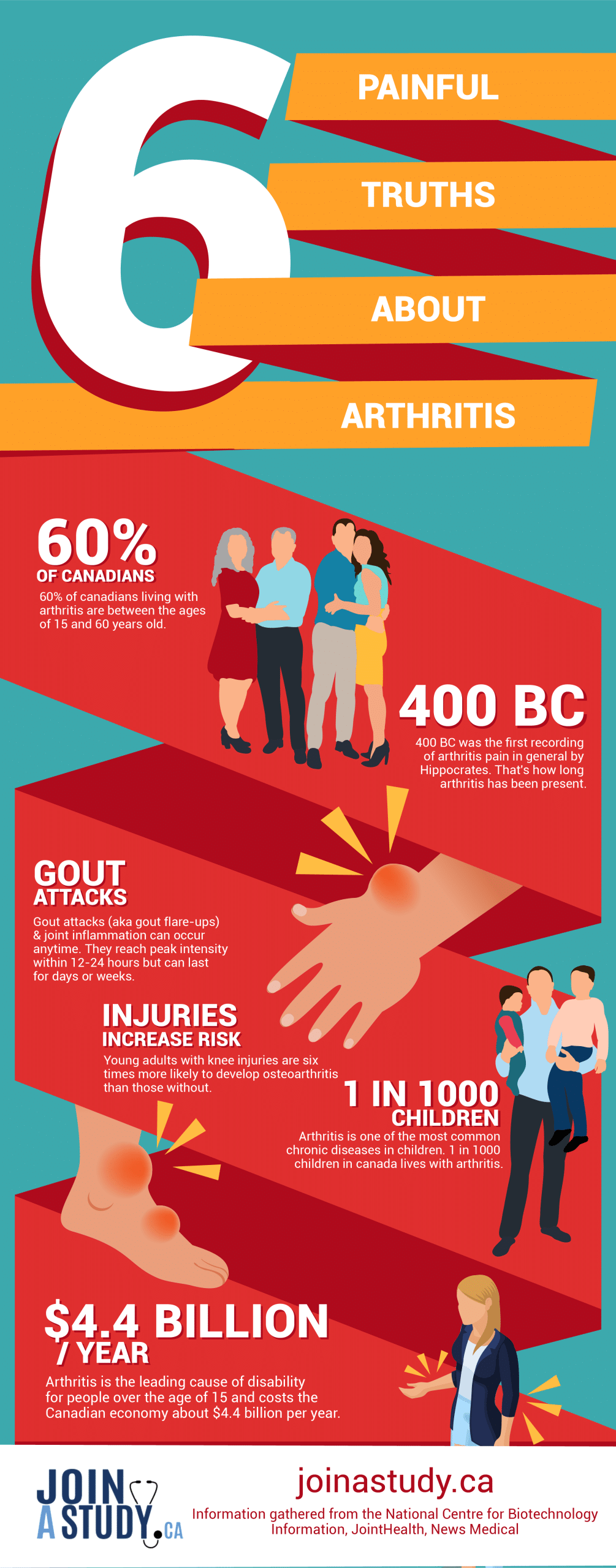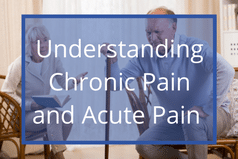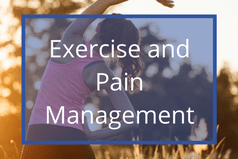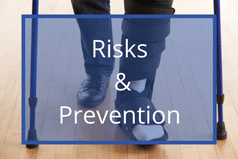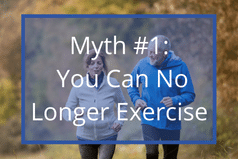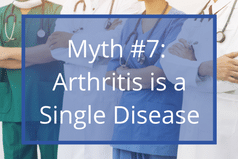Individuals can be predisposed to arthritic conditions if they exhibit one or multiple risk factors.
Some of these risk factors are beyond an individual’s control, such as sex and age. Some risk factors can be controlled, such as the level of physical activity and a person’s weight. Additional risk factors have been linked to arthritis and chronic pain, including broken bones, frequent texting over long periods of time, and a low index-to-ring-finger ratio.
There are measures you can take to minimize the effects of arthritis and chronic pain. Simple, everyday tasks can keep your bones and joints healthy, including:
- Stretches
- Low-impact activities
- Muscle-strengthening exercises
- Core exercises
Understanding Chronic Pain and Acute Pain
Acute and chronic pain can have different causes and require different courses of treatment. Acute pain is caused by a specific injury or disease, whereas chronic pain outlasts the initial cause of that pain. For example, if a person broke an arm and continued to experience pain long after the bone was healed, that would be identified as chronic pain.
Acute pain, by contrast, alerts the body to injury. The pain doesn’t last long beyond the cause of the pain itself, meaning that the pain should subside as the body heals.
If pain lasts longer than three months after sustaining an injury, it is recommended that you seek medical attention, since you may have a chronic pain condition.
Exercise and Pain Management
Before participating in physical activity, it’s best to consult a doctor to confirm that the exercise in question would be beneficial. One should then consult a physiotherapist to create an exercise plan.
Potential suggestions from physiotherapists may resemble these activities:
- Group exercise classes
- Yoga
- Playing non-contact sports with family
- Stretching
Arthritis commonly affects the joints within the hands in rheumatoid arthritis and juvenile arthritis. Those suffering from joint pain in the hands may wish to inquire with a doctor about these seven exercises.
- Making a fist
- Bending fingers
- Bending thumbs
- Making a circle with your fingers and thumb
- Bending fingers on a surface
- Lifting fingers on a surface
- Stretching wrists gently
Lower back pain can disrupt regular activity but often subsides within 6-8 weeks. However, there are some exercises that you can do on your own to alleviate minor pain during that time after consulting with a physician.
Those measures include:
- Applying ice and heat to the affected area
- Moderate levels of consistent activity
- Regular stretching
- Ergonomic chairs
- Supporting your back with a bed wedge
- Using a proper pillow
Risks & Prevention
There is no definitive cause for arthritis, however, people could be predisposed to arthritic conditions if they exhibit one or multiple risk factors
Some of these risk factors are beyond individual control, as gender and age are believed to contribute to the disease. Some risk factors can be controlled, such as low physical activity and a person’s weight. Additional risk factors have been linked to arthritis and chronic pain conditions as well, including broken bones, frequent texting over time, and a low index-to-ring-finger ratio.
There are measures you can take to keep your body strong and healthy, even as you age. Simple, everyday tasks can keep your bones and joints healthy, including:
- Stretches
- Low-impact activities
- Muscle-strengthening exercises
- Core exercises
Myth #1: You Cannot Exercise When Affected by Arthritis
Moderate exercise is safe, and research has shown that further injury is not likely if precautions are taken to avoid extreme activity.
The relevant benefits of exercise include:
- Strengthening muscles to improve joint support
- Weight management, reducing stress on joints
- Quality of life improvements
- Quality of sleep improvements
- Balance improvements
- Maintaining bone strength
People affected by arthritis can maintain a healthy amount of exercise with moderate levels of activity. Avoid strenuous activities. Engage in low-impact activities, such as walking and recreational swimming.
Individuals may need to adapt fitness regimes to their own needs and limitations. In that case, the following activities can mitigate the risk of triggering arthritis-related pain while staying active.
Group Classes
Health clubs often host classes specifically for those dealing with mobility issues, chronic pain, or arthritis, including spin classes, stretch and mobility classes, or light swimming classes.
Adaptive Yoga
Variations of traditional yoga (such as chair yoga) are considered to be more manageable for pain due to the assistance of a supporting object.
Household Activity
By helping clean or cook (without straining oneself), it is possible to remain active without having to visit a fitness club.
Exercising at Home
Consult with a doctor about trying these exercises at home:
- Leg raises
- Stretching hamstrings
- Half-squats
- Leg stretches
- One-leg dips
Myth #2: Arthritis Only Affects the Elderly
Juvenile arthritis involves joint swelling and inflammation in children aged 16 and under. It’s an autoimmune disease that can often be difficult to diagnose due to the number of symptoms it shares with other diseases.
- Weight loss
- Joint stiffness
- Fatigue
- Irritability
- Blurred vision
Approximately one in every 1,000 children is diagnosed with juvenile arthritis.
Rheumatoid arthritis usually begins in the 30 to 50 age groups, but can develop at any age.
Myth #3: Medication is the Only Way to Treat Arthritis and Chronic Pain
Medication is not the only option when it comes to coping with chronic pain.
Alternate means of pain relief that may work for you include:
- Hot and cold treatments
- Magnets (for osteoarthritis)
- Mind and body therapies
- Supplements
- Topical creams, gels or patches containing capsaicin (pepper)
Cold treatments, such as a cold compress or a cooling topical analgesic, can be used to alleviate pain from inflamed joints. Heating tense muscles through a warm compress and a hot shower can relax stiff muscles, improve range of motion, and increase blood flow.
Myth #4: You Can’t Prevent Arthritis
While there is not much we can do to prevent juvenile or rheumatoid arthritis, there are some actions you can take to prevent or delay the onset of osteoarthritis.
These include:
- Eating fish
- Managing body weight
- Exercising
- Avoiding injuries
- Protecting joints (e.g., using proper lifting techniques)
- Visiting a doctor for regular check-ups
Anti-inflammatory diets may also contribute toward minimizing joint pain.
Myth #5: Cracking Your Knuckles Causes Arthritis
Consistent evidence has not been found to suggest that cracking knuckles causes arthritis.
Pulling on fingers or knuckles to make them ‘crack’ creates a displacement of nitrogen gas within the joint, which generates a popping noise.
A majority of the research conducted on links between joint-cracking and arthritis has been inconclusive. The occasional crack of the neck is considered to be a normal occurrence. However, experiencing a frequent cracking or grinding sensation may warrant a consultation with a doctor if it continues over a certain length of time.
Myth #6: Dietary Choices do not Affect Your Symptoms
Certain foods may worsen symptoms of rheumatoid arthritis, including:
- Red meat
- Sugar and refined flour
- Processed and fried foods
- Gluten
- Alcohol
Replace them with foods such as these:
- Fish
- Whole grains
- Fruits and vegetables
- Beans
Unfortunately, there is no cure-all food that completely alleviates arthritic pain. However, some do help reduce inflammation.
Myth #7: Arthritis is a Single Disease
Arthritis is an umbrella term that can be used to describe over 100 different medical conditions, including osteoarthritis, rheumatoid arthritis, psoriatic arthritis, and gout – just to name a few.
The symptoms and the treatments for these various arthritic conditions vary. Consult with a doctor if you think you may have a form of arthritis. Do not attempt to treat a condition based on a self-diagnosis.
Resources
JoinAStudy uses only trusted resources such as those that comply with the Health On The Net Code of Conduct (HONcode), thereby ensuring that we are providing high-quality health information to professionals and the general public. The information that is provided should not be taken as professional medical advice. If you are having issues or have health-related concerns, you should see your personal physician.
Allina Health, Five Benefits of Chair Yoga: https://www.allinahealth.org/healthysetgo/singlearticle.aspx?id=36507248328
Arthritis-Health, Exercising with Arthritis:
https://www.arthritis-health.com/treatment/exercise/exercising-arthritis
Arthritis-Health, When and Why to Apply Cold to an Arthritic Joint:
https://www.arthritis-health.com/treatment/alternative-treatments/when-and-why-apply-cold-arthritic-joint
Everyday Health, 6 Foods to Avoid with Rheumatoid Arthritis:
https://www.everydayhealth.com/hs/guide-to-managing-ra/foods-to-avoid/
Everyday Health, 7 Unexpected Arthritis Risk Factors:
https://www.everydayhealth.com/arthritis-pictures/7-unexpected-arthritis-risk-factors.aspx
Everyday Health, Arthritis Can Strike Children:
https://www.everydayhealth.com/arthritis/arthritis-can-strike-children/
Everyday Health, Hot and Cold Therapy for Arthritis Joint Pain:
https://www.everydayhealth.com/arthritis/heat-and-cold-therapy.aspx
Everyday Health, Myths and Facts About Joint Pain:
https://www.everydayhealth.com/arthritis/joint-myths-facts.aspx
Everyday Health, Will Joint Cracking Cause Arthritis?
https://www.everydayhealth.com/specialists/arthritis/kitridou/qa/will-joint-cracking-cause-arthritis.aspx
Health Communities, Risk Factors and Causes of Arthritis:
http://www.healthcommunities.com/arthritis/causes.shtml
Healthline, 7 Anti-Inflammatory Recipes:
https://www.healthline.com/health/anti-inflammatory-recipes-for-arthritis#modal-close
Healthline, Arthritis Prevention: What Can You Do?:
https://www.healthline.com/health/arthritis-prevention
Healthline, Easy Exercises for Knee Arthritis:
https://www.healthline.com/health/osteoarthritis/easy-excercises-knee
Join a Study, Arthritis in Your Hands: 7 Exercises to Alleviate Symptoms:
https://joinastudy.ca/arthritis-hands-7-exercises-help-alleviate-symptoms/
Join a Study, 7 Products and Tips to Relieve Lower Back Pain
https://joinastudy.ca/7-products-tips-relieve-lower-back-pain/
Join a Study, How to Exercise When You Have Chronic Pain:
https://joinastudy.ca/exercise-chronic-pain/
Join a Study, 17 Preventative Tips to Keep Your Bones and Joints Healthy:
https://joinastudy.ca/17-tips-to-keep-your-bones-and-joints-healthy/
JointHealth, insight, Arthritis across Canada:
http://jointhealth.org/programs-jhmonthly-view.cfm?id=47&locale=en-CA
Mayo Clinic, Definition, Back pain:
https://www.mayoclinic.org/symptoms/back-pain/basics/definition/sym-20050878
Mayo Clinic, Exercise Helps Ease Arthritis Pain and Stiffness:
https://www.mayoclinic.org/diseases-conditions/arthritis/in-depth/arthritis/art-20047971
National Center for Biotechnology Infomation, The Prevalence of Chronic Pain in Canada:
https://www.ncbi.nlm.nih.gov/pmc/articles/PMC3298051/
National Center for Biotechnology Information, The Difference Between Acute and Chronic Pain:
https://www.ncbi.nlm.nih.gov/pubmed/1875958
News Medical, Rheumatoid Arthritis History:
https://www.news-medical.net/health/Rheumatoid-Arthritis-History.aspx
News Medical, Thirteen Myths About Arthritis and Rheumatic Disease:
https://www.news-medical.net/news/20101108/Thirteen-myths-about-arthritis-and-rheumatic-disease.aspx
Spinal-Health, Should I Worry About Cracking My Neck?:
https://www.spine-health.com/blog/should-i-worry-about-my-neck-cracking
WebMD, Can a Sports Injury Raise My Osteoarthritis Risk?
https://www.webmd.com/osteoarthritis/guide/osteoarthritis-sports-injury-risk#1
UptoDate, Patient Education: Gout (Beyond the Basics)
https://www.uptodate.com/contents/gout-beyond-the-basics
WebMD, 4 Foods to Fight Rheumatoid Arthritis Inflammation:
https://www.webmd.com/rheumatoid-arthritis/ra-foods#1
WebMD, Is Your Pain Acute or Chronic?:
https://www.webmd.com/pain-management/features/types-pain
WebMD, Diagnosing Juvenile Arthritis:
https://www.webmd.com/rheumatoid-arthritis/diagnosing-juvenile-arthritis
WebMD, Are There Natural Treatments for RA?
https://www.webmd.com/rheumatoid-arthritis/guide/rheumatoid-arthritis-natural-treatments#3
WebMD, Rheumatoid Arthritis and Food: Myths and Facts:
https://www.webmd.com/rheumatoid-arthritis/ss/slideshow-rheumatoid-arthritis-food-myths-and-facts


